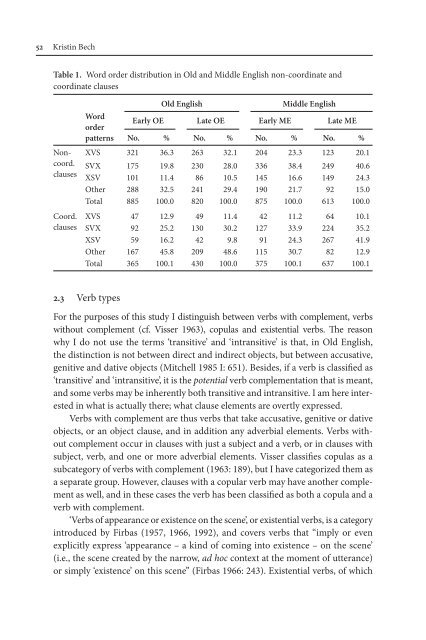Selected Papers from the Fourteenth International ... - STIBA Malang
Selected Papers from the Fourteenth International ... - STIBA Malang
Selected Papers from the Fourteenth International ... - STIBA Malang
Create successful ePaper yourself
Turn your PDF publications into a flip-book with our unique Google optimized e-Paper software.
52 Kristin Bech<br />
Table 1. Word order distribution in Old and Middle English non-coordinate and<br />
coordinate clauses<br />
Noncoord.<br />
clauses<br />
Coord.<br />
clauses<br />
Old English Middle English<br />
Word<br />
order<br />
Early OE Late OE Early ME Late ME<br />
patterns No. % No. % No. % No. %<br />
XVS 321 36.3 263 32.1 204 23.3 123 20.1<br />
SVX 175 19.8 230 28.0 336 38.4 249 40.6<br />
XSV 101 11.4 86 10.5 145 16.6 149 24.3<br />
O<strong>the</strong>r 288 32.5 241 29.4 190 21.7 92 15.0<br />
Total 885 100.0 820 100.0 875 100.0 613 100.0<br />
XVS 47 12.9 49 11.4 42 11.2 64 10.1<br />
SVX 92 25.2 130 30.2 127 33.9 224 35.2<br />
XSV 59 16.2 42 9.8 91 24.3 267 41.9<br />
O<strong>the</strong>r 167 45.8 209 48.6 115 30.7 82 12.9<br />
Total 365 100.1 430 100.0 375 100.1 637 100.1<br />
2.3 Verb types<br />
For <strong>the</strong> purposes of this study I distinguish between verbs with complement, verbs<br />
without complement (cf. Visser 1963), copulas and existential verbs. The reason<br />
why I do not use <strong>the</strong> terms ‘transitive’ and ‘intransitive’ is that, in Old English,<br />
<strong>the</strong> distinction is not between direct and indirect objects, but between accusative,<br />
genitive and dative objects (Mitchell 1985 I: 651). Besides, if a verb is classified as<br />
‘transitive’ and ‘intransitive’, it is <strong>the</strong> potential verb complementation that is meant,<br />
and some verbs may be inherently both transitive and intransitive. I am here interested<br />
in what is actually <strong>the</strong>re; what clause elements are overtly expressed.<br />
Verbs with complement are thus verbs that take accusative, genitive or dative<br />
objects, or an object clause, and in addition any adverbial elements. Verbs without<br />
complement occur in clauses with just a subject and a verb, or in clauses with<br />
subject, verb, and one or more adverbial elements. Visser classifies copulas as a<br />
subcategory of verbs with complement (1963: 189), but I have categorized <strong>the</strong>m as<br />
a separate group. However, clauses with a copular verb may have ano<strong>the</strong>r complement<br />
as well, and in <strong>the</strong>se cases <strong>the</strong> verb has been classified as both a copula and a<br />
verb with complement.<br />
‘Verbs of appearance or existence on <strong>the</strong> scene’, or existential verbs, is a category<br />
introduced by Firbas (1957, 1966, 1992), and covers verbs that “imply or even<br />
explicitly express ‘appearance – a kind of coming into existence – on <strong>the</strong> scene’<br />
(i.e., <strong>the</strong> scene created by <strong>the</strong> narrow, ad hoc context at <strong>the</strong> moment of utterance)<br />
or simply ‘existence’ on this scene” (Firbas 1966: 243). Existential verbs, of which










